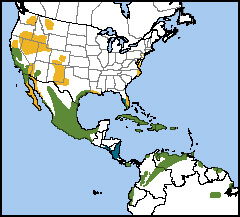 “Long” and “thin” are the best adjectives for describing this elegant black and white shorebird: long neck; thin, needle-like black bill; and long, pink legs. Black-necked Stilts have the second-longest legs in proportion to their bodies of any bird—only a flamingo's are longer.
“Long” and “thin” are the best adjectives for describing this elegant black and white shorebird: long neck; thin, needle-like black bill; and long, pink legs. Black-necked Stilts have the second-longest legs in proportion to their bodies of any bird—only a flamingo's are longer.
The Black-necked Stilt is vulnerable to habitat loss and pollution runoff, particularly from pesticides. The stilt can be found at many sites where ABC works on the Gulf Coast, often nesting alongside Least Terns and Wilson's Plovers.
Black-necked Stilts are found in wetlands from North America and the Caribbean south to central Argentina. They are sensitive to the drying of ponds caused by drought, which has increased with global climate change; however, the species readily adopts new breeding areas such as sewage ponds, dikes, and other man-made habitats.
Sign up for ABC's eNews to learn how you can help protect birds
Although Black-necked Stilt populations in the continental U.S. appear stable, a Hawaiian subspecies, the Ae'o, is considered federally endangered and is on the 2014 State of the Birds Watch List. It is particularly threatened by introduced predators, including feral cats.

Black-necked Stilt sheltering chicks. Photo by Dennis Jacobsen, Shutterstock
Deceptive Displays
Black-necked Stilts nest on open ground in loose colonies, sometimes alongside other shorebirds such as the American Avocet. The nest site is usually located on bare open ground or in short vegetation, surrounded by water; the nest itself is built by both sexes, and may be a simple scrape in the soil or a mound of vegetation built up above water level and lined with pebbles, shells, and debris.
These shorebirds are strongly territorial and, like Piping and Snowy Plovers, attempt to deter potential predators with “broken wing” distraction displays. Another distraction display they deploy is “false incubation,” in which an adult crouches on the ground—as if incubating eggs—then gets up, moves to another spot, and crouches again. Both types of display lure potential predators away from the birds' nests and eggs.
A unique display the stilt uses is the “popcorn display”: all the adult stilts in a colony alternately hop up and down while wildly flapping their wings and calling loudly and incessantly at offending intruders.
Both parents incubate the eggs. On very hot days, stilts may soak their belly feathers to carry water to the nests, sometimes making more than a hundred trips a day to keep their eggs cool. The downy young leave the nest only an hour or two after hatching. And although both parents tend the chicks, they are capable of feeding themselves.
Picky Eaters
The Black-necked Stilt can swim and dive if necessary, but prefers to wade in shallow water as it feeds, probing with its long, thin bill for insects and crustaceans on or near the surface of water. It finds most of its food visually, picking insects, small crustaceans, and tiny fish from the surface of the water or mud. Stilts also eat some seeds of aquatic plants, and on some lakes, may feed heavily on brine shrimps and brine flies.
Saving Stilts and Other Shorebirds
“The protective fencing we put up around Least Tern and Wilson's Plover nesting sites is also protecting Black-necked Stilt nests,” says Kristen Vale, Coastal Program Coordinator for ABC's Beach-nesting Bird Conservation Program in Texas. “Our stewardship efforts are also helping protect their eggs and chicks. Currently at one busy recreation site there are at least two active nests, one outside of protective fencing, and just this week I saw baby stilt chicks in a vulnerable spot near where vehicles pass and park. I am going to be spending a lot of effort this July 4th weekend to protect these nests and chicks from cars and people.”
Read more about how ABC's Gulf Coast Birds Program is making a positive difference for shorebirds like the Black-necked Stilt, and discover ways you can help.
Donate to support ABC's conservation mission!



















































